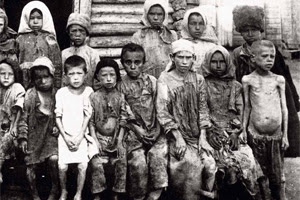 Cruel efforts under Stalin to impose collectivism and tamp down Ukrainian nationalism left an estimated 3.9 million dead.
Cruel efforts under Stalin to impose collectivism and tamp down Ukrainian nationalism left an estimated 3.9 million dead.
 Stalin believed any future insurrection would be led by the Kulaks, thus he proclaimed a policy aimed at "liquidating the Kulaks as a class."
Stalin believed any future insurrection would be led by the Kulaks, thus he proclaimed a policy aimed at "liquidating the Kulaks as a class."
 Arts and Humanities.
Arts and Humanities.
Many kulaks burnt their own crops and killed livestock in protest. There has been a great deal of debate about this, but the most recent estimates are converging on a figure of around 10 million. Their numbers dwindled to less than half of what they had been before the revolution. Some kulaks were killed, others fled, and still others lost some or all of their holdings. Later with Stalin in sole power of the USSR, he created a program to wipe out the peasant farmer class completely. Some villages were. The killing of livestock and burning crops contributed. Please help, thank youu! A collective farm. The poor peasants improved their situation by appropriating land and other property from large landowners. A U.N. joint statement signed by 25 countries in 2003 declared that 7–10 million perished. Jason B. Lv 5. Kulak, (Russian: “fist”), in Russian and Soviet history, a wealthy or prosperous peasant, generally characterized as one who owned a relatively large farm and several head of cattle and horses and who was financially capable of employing hired labour and leasing land.Before the Russian Revolution of 1917, the kulaks were major figures in the peasant villages. Science. Collectivisation killed about 2.5 million in Ukraine and about half a million in the rest of the country mostly killed… He put them in camps were the were starved, the food was taken away from them and many people died. At its height the Gulag consisted of many hundreds of camps, with the average camp holding 2,000–10,000 prisoners. Historians estimate the … Other. Many were so emaciated, he recalled, that their bodies began to swell and stink from the extreme lack of nutrients. Social Science. Literally millions of Kulaks … Stalin’s Great Purge: Over A Million Detained, More Than Half A Million Killed. However, they were simply dumped off in the middle of nowhere, without food, supplies, or resources of any kind. How many people were killed as a result of Collectivisation in Russia? 26 million catlle 15 million horses. Some were shot, others died from starvation or cold either on the way to labour camps or during their time working there. The reported number of kulaks and their relatives who had died in labour colonies from 1932 to 1940 was 389,521. The … Thirty percent of the officers that were expelled were allowed to return to their duties during WWII. Answer Save. five million households; Subjects. 1 decade ago. They were formerly wealthy farmers that had owned 24 or more acres, or had employed farm workers. Kulaks were transported to Siberia, which was bad enough. It involved a large-scale purge of the Communist Party and government officials, repression of kulaks and the Red Army leadership, widespread police surveillance, suspicion of saboteurs, counter-revolutionaries, imprisonment, and arbitrary executions. The “Kulaks” ... as many of them were merely stripped of their duties and expelled from the Party. who were Kulaks? He hated the Kulaks so much many … In the process of collectivization, for example, 30,000 kulaks were killed directly, mostly shot on the spot. Dekulakisation as a policy was formally abandoned in 1954, the year after Stalin died, when many deported "kulaks" were released. Kulaks that resisted were killed. Quizlet Learn. surrounded and destroyed. Stalin was a very cruel man and he singled out the kulaks. kulaks were killed. rich peasants. Favorite Answer. But it was not until 1991 that they and their descendants, with other victims of political repression, were formally rehabilitated. Most of these camps were “corrective labour colonies” in which prisoners felled timber, laboured on general construction projects (such as the building of canals and railroads), or worked in mines.
 Cruel efforts under Stalin to impose collectivism and tamp down Ukrainian nationalism left an estimated 3.9 million dead.
Cruel efforts under Stalin to impose collectivism and tamp down Ukrainian nationalism left an estimated 3.9 million dead. Stalin believed any future insurrection would be led by the Kulaks, thus he proclaimed a policy aimed at "liquidating the Kulaks as a class."
Stalin believed any future insurrection would be led by the Kulaks, thus he proclaimed a policy aimed at "liquidating the Kulaks as a class." Arts and Humanities.
Arts and Humanities.